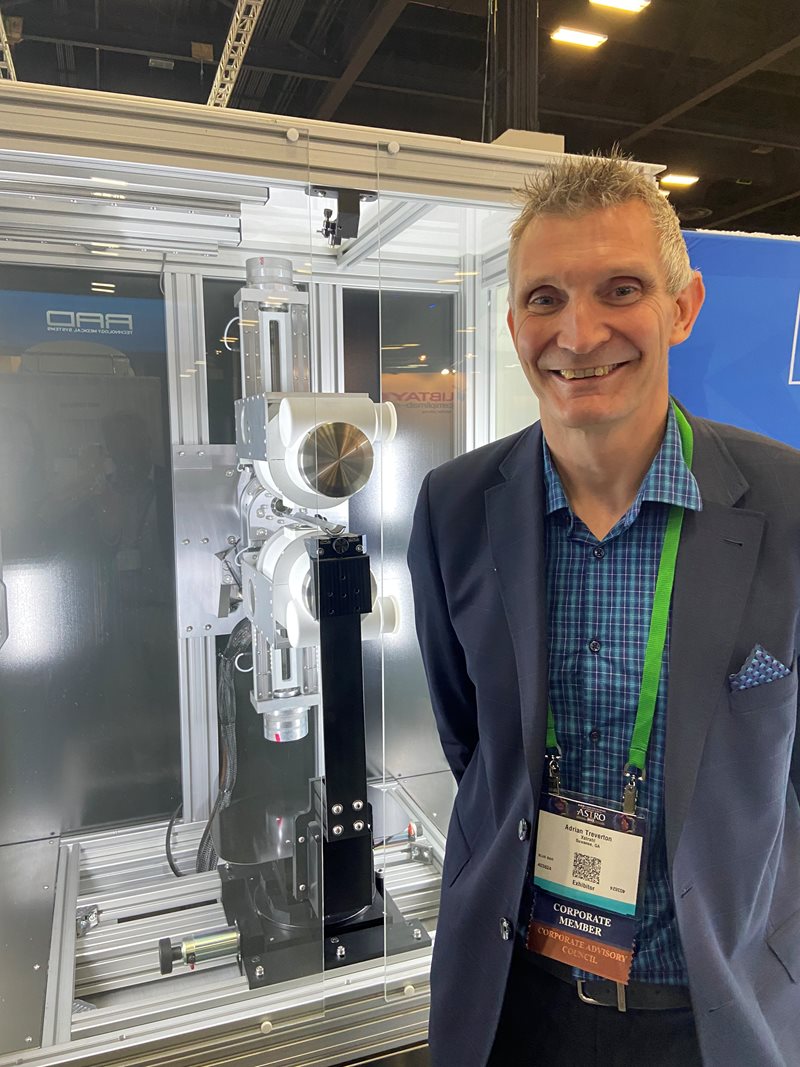ASTRO 22: Xstrahl Highlights Access Benefits, Capabilities of X-ray FLASH Radiation Therapy
 Xstrahl, a medical technology company that designs radiation delivery devices to support clinical teams and cancer researchers, showcased its ultra-high-dose-rate (UHDR) x-ray-based FLASH capabilities at the ASTRO annual meeting held Oct. 23-26 in San Antonio, providing options for alternative treatments and research technologies to help eradicate cancer.
Xstrahl, a medical technology company that designs radiation delivery devices to support clinical teams and cancer researchers, showcased its ultra-high-dose-rate (UHDR) x-ray-based FLASH capabilities at the ASTRO annual meeting held Oct. 23-26 in San Antonio, providing options for alternative treatments and research technologies to help eradicate cancer.
“Our niche is really delivering x-rays,” explained Adrian Treverton, (pictured right) CEO of Xstrahl, a company that has been shaping the development of superficial and orthovoltage therapies for over 20 years. “We bring the technology where it needs to be, whether that be to a radiation oncology clinic, dermatology practice, or radiation research facility.”
ASTRO has become a regular meeting for the leaders of the company, who focus on connecting with a broad range of health care experts including radiation oncologists, dermatologists, academic researchers, and biotech and pharmaceutical personnel. Xstrahl solutions deliver radiation therapy for nonmelanoma skin cancers and dermatological conditions in clinical use. By enabling preclinical image-guided studies in radiation research, Xstrahl also helps facilitate investigation of radiation—particularly x-ray-based FLASH radiation therapy—which delivers radiation at an ultra-high-dose rate orders of magnitude higher than conventional irradiation with fewer side effects. Using Xstrahl’s state-of-the-art small animal radiation research platform, SARRP, research discoveries can be transitioned to clinical use.
“Doing all this preclinical work is hugely important for something like FLASH, which really could be a new cornerstone of radiation therapy,” Treverton said. “Some might say, ‘It’s too good to be true,’ so allowing people access to do this research will have a massive impact on oncology radiation. We’re all about getting delivery to humans faster. Everything we do here will drive that translational research.”
At its booth, the company showcased a model of the first commercially available x-ray-based FLASH irradiator for preclinical radiation research. “It looks big, but compared to an electron or a proton system, it’s tiny,” said Amanda Tulk, chief science officer at Xstrahl. “You can literally put it anywhere, as long as the floor can hold it. That's the only limit.”
“There are so many questions to be answered around FLASH. And so little places are equipped to do it, and this would really help with that,” Tulk continued.
“We need to understand why [it works], and at what optimal dose rates. And that's what this is going to help people do,” Treverton said of the company’s preclinical applications.
Overall, Xstrahl systems are in operation at more than 700 treatment and research facilities globally. Nonmelanoma skin cancer, with 5.4 million cases annually in the US, is a growing area of application for its electronic brachytherapy and superficial radiation therapy technology, which can treat the cancers noninvasively.
“People these days don’t just accept, ‘Oh, we’re going to cut it out,’” Treverton said, explaining that basal cell and squamous cell carcinoma patients are typically solid candidates for electronic brachytherapy and superficial radiation therapy. Patients with frequently recurring disease, those with head and neck lesions, and elderly patients may also prefer noninvasive radiation therapy treatment.